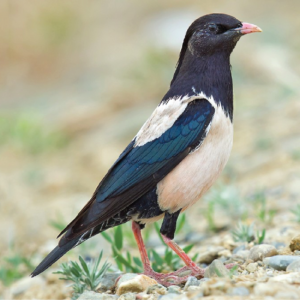Rosy Starling

- Distribution: Breeds in Eastern Europe and Central Asia, migrates to South Asia during winter.
- Habitat: Open woodlands, grasslands, agricultural areas, urban parks.
- Diet: Omnivorous, feeding on insects, fruits, seeds, and occasionally small vertebrates.
- Size: Approximately 18-20 cm in length.
Also referred to as the rose-colored pastor or rose-colored starling, the rosy starling (Pastor roseus) is a passerine bird in the Sturnidae starling family.
With its glossy black head, wings, and tail, pale orange legs and bill, and pink body, the adult rosy starling is a very recognizable bird. During the breeding season, males have longer head feathers that curl up into a wispy crest that becomes more noticeable and fluffed as the bird becomes agitated. The crest is truncated in the winter, and the black feathers inside the plumage lose some of their pigment and become lighter. Male winter plumage is relatively drab.
In contrast, females lack the distinct pink and black distinction and have a shorter crest.
It migrates strongly and spends the winter in tropical Asia and India. It frequently seems to outnumber the native starlings and mynas in India throughout the winter. The pink starling inhabits wide agricultural areas and steppes.
The highly gregarious rosy starlings (Pastor roseus) are drawn to flowering trees, which can occasionally cause problems for orchard and cereal crop growers due to their big, noisy flocks.
Fruits, berries, flower nectar, cereal grains, and insects are the main foods that the rosy starling consumes. The following is a specific list of the food categories that rosy starlings have been observed to prefer: berries and fruits.
